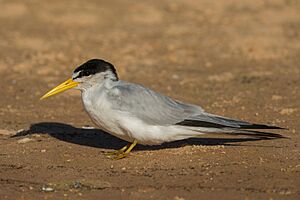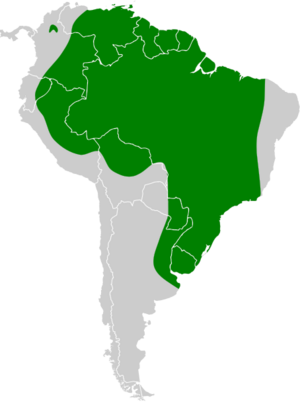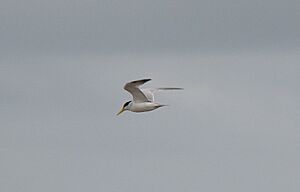Yellow-billed tern facts for kids
Quick facts for kids Yellow-billed tern |
|
|---|---|
 |
|
| Conservation status | |
| Scientific classification | |
| Genus: |
Sternula
|
| Species: |
superciliaris
|
 |
|
| Synonyms | |
|
Sterna superciliaris |
|
The yellow-billed tern (Sternula superciliaris) is a small bird that lives near water in South America. It's a type of tern, which is a seabird. You can find these birds in many countries, including Argentina, Brazil, Colombia, and Peru. They love places like rivers, swamps, and freshwater lakes.
Contents
About the Yellow-Billed Tern
The yellow-billed tern is a small bird. It grows to be about 23 to 25 centimeters long. That's roughly the length of a ruler! It weighs between 40 and 57 grams. This is about the same as a small candy bar.
What Does It Look Like?
This bird has a bright yellow beak and yellow feet. Its wings are a shiny silver-grey color. The feathers on its belly and forehead are white. A black cap covers its head. It also has a black line near its eyes. Young yellow-billed terns look a bit different. They are brown and white. They do not have the black cap that adult birds have.
Nesting and Reproduction
Yellow-billed terns often build their nests near other birds. They might nest with large-billed terns or black skimmers. This helps them stay safe from predators.
Where Do They Nest?
These terns breed from August to December. They choose sandy banks and island beaches for their nests. When it's not breeding season, they live in other places. These include coastal lagoons, river mouths, and even rice fields.
Their Nests and Eggs
Their nests are simple. They are just shallow scrapes in the sand. Most of the time, a female tern lays two eggs. But she can lay anywhere from one to four eggs. The eggs hatch after about 24 days. This is called the incubation period. Terns usually build their nests very close to each other. They are very brave and protect their nests from animals that might try to eat their eggs or chicks. Other birds, like the sand-colored nighthawk, sometimes nest near tern colonies. They do this to get protection from the terns!
What Do Yellow-Billed Terns Eat?
The yellow-billed tern looks for food during the day. They mostly eat small fish and shrimp. They also enjoy eating insects.
How They Catch Food
These birds are skilled hunters. They fly above the water and hover in one spot. Then, they quickly pick fish from the water's surface.



